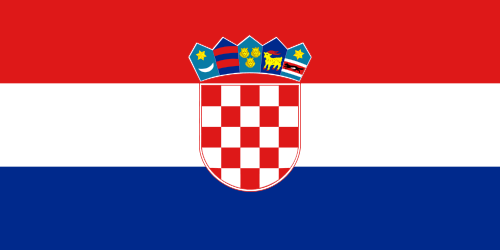
Country Flags by Continent
|
|
The Croatian flag consists of three equal size, horizontal stripes in the pan-Slavic colours red, white and blue. The flag combines the colours of the flags of the Kingdom of Croatia (red and white), the Kingdom of Slavonia (white and blue) and the Kingdom of Dalmatia (red and blue). Those three kingdoms are the historic constituent states of the Croatian Kingdom. In the middle is the Coat of Arms of Croatia.
The red-white-blue tricolour has been used as the Croatian flag since 1848, symbolising the Pan-Slavic colours. While the Banovina of Croatia existed within the Kingdom of Yugoslavia, it had a similar flag without the modern crown above the chequy. While Croatia was part of SFR Yugoslavia its tricolour was the same, but it had a five-pointed red star with a yellow border in place of the coat of arms. The star was replaced by the coat in May 1990, shortly after the first multi-party elections. The current flag and the coat of arms were officially adopted on December 21, 1990, about ten months before the proclamation of independence from Yugoslavia and a day before the Constitution of Croatia on 22 December 1990. The shield is in the red and white checks of Croatia. Above is a crown made of shields of its various regions. From left to right they are the ancient arms of Croatia, Dubrovnik, Dalmatia, Istria, and Slavonia.
Overview
Croatian horizontal tricolour of red, white and blue inherited it's colours, of course, from the Croatian coats of arms: Croatian chequered red and silver, Dalmatian blue with three golden leopards, and Slavonian blue with red field with black marten bordered with two white wavy lines, and golden star above. All of the three coats were, in fact, used in different times for all the land, as it is with the name also. Later in 19th cent. the geographical meaning of these names was finally firmly established. The land was named in 19th cent Triunar (meaning one made of three) Kingdom of Croatia, Slavonia and Dalmatia. Therefore, it is not unusual that the flag was made of all three colours.
The first time that it was officially proclaimed was in 1848 and under the influence of revolutionary movements in Europe, a simple tricolour was made. The flag was, of course, without any coat. However, it was used as local flag in a big empire, so it remained more or less internationally unknown, but it became one of the most important symbols of the Croatian people. Very often it can be seen on old postcards, most often together with Croatian coats (normally not on the flag, but from time to time as a part of the flag).
After the end of the World War Croatia proclaimed independence, and a tricolour became the state flag, again without coats. The collision with the Dutch flag didn't became, as a matter of fact, a problem, because the state was short living. After a short time, Croatia was united with Slovenia and Bosnia and Herzegovina in the State of Slovenians, Croats and Serbs (not to be mistaken with the later Kingdom of Serbs, Croats and Slovenians), and a month later occupied by Serbian forces united in a Kingdom under Serbian dynasty which already had annexed Montenegro. This state was then named Kingdom of Serbs, Croats and Slovenes, and took a neutral combination of pan-slavene colours blue white red (both Serbia and Montenegro had red blue white and Slovenia white blue red).
The Croatian flag again remained as local flag, highly respected by the people, but half illegal, as the Belgrade government tried to unite all nations into a Yugoslav nation. These efforts didn't succeed, and in 1938 a separate province (banovina) of Croatia was made. It took, as one can expect, the red white blue tricolour and in official use the coat of the province in the middle. By this time many Croatian political parties used the Croatian tricolour with their respective symbol in the middle. The best known was the Croatian Peasant Party, HSS, with a chequered red white field bordered green. Željko Heimer, 14 October 1995
After description of the austro-hungarian flags used on sea during 19th century on eastern Adriatic, and after a paragraph on national colours (i.e. Croatian national tricolour based flags) used as house flags and owner's signals on ships beside the A-H ensign, Isaic writes: "For river navigation the flag hoisting was solved with legislation of 1869 according to which each ship was to hoist its national flag. The first Croatian river ship "Sloga" was owned by Savsko-kipsko d.d. from Sisak, acquired in 1844." This hints at least that the ships on rivers used national flags as opposed to the flag of the Dual Monarchy, and that this "national" is mean the flags of Croatia (Hungary, Austria etc. as appropriate). The year of 1869 is also the year of the Croatian-Hungarian Treaty with which the duties and authorities of the two kingdoms were in details defined. Weather this is the 1869 legislation Isaic refers, I don't know. If so, then possibly other A-H crownlands were not in that legislation, but if it was some kind of wider legislation, it may be that the same was prescribed for e.g. Czech ships on rivers, and maybe some others too.
Flag meaning
One of interpretations of colours dating from late 19th century is Red Croatia, White Croatia, and Kingdom of Slavonia (blue). Red and White Croatia are Croatian states from early middle age, approximately in today's Dalmatia (Red) and central Croatia and Bosnia and Herzegovina (White).
And finally to mention an interpretation of colours of the Croatian flag made by Miroslav Krleza, a great national writer, saying that the colours represent the three symbols of Croatian history and people: blood of Croatian martyrs, Croatian peaceful lamb like nature, and Croatian devotion to God.
|

